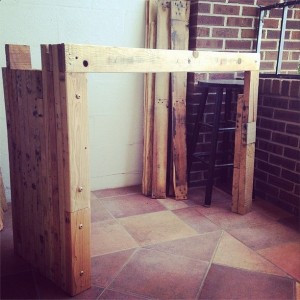Woodworking is therapeutic to me. It gives me something on which to focus my creative energies. It lets me use my hands in a constructive way, something I do not do during my daily work.
One thing I love about woodworking is that it makes the carpenter slow down. I have found that the more I try to rush, the less perfect the outcome.
For example, the last time I got to work on my current project, I was frustrated with the materials at hand and I rushed because I was wasn’t getting as much done. The wood I had at my disposal wasn’t quite straight so I had to affix multiple pieces together like Frankenstein. Then my calculations were off because I didn’t take into account the girth of the lumber.

This of course made for a very shoddy TV Stand.
The Parallel
We’ve all had this problem with our work at some point or another. You do some sort of work, make a decision, or have a meeting and you don’t really feel like it was your best effort. But that’s all you can muster at the time.
Then you’re stuck with the decisions. Then you push forward and keep building on a lame idea. You eventually come out with a finished product that looks OK, but at the core you know it’s shaky.
That’s how I felt about the TV Stand. If I kept moving forward I could probably smooth it out and make it look pretty with gloss and some heavy-duty sanding. But it would be unstable and I would know that I skimped on the quality.
If I always “shipped” work with this mentality, just cover up the mistakes & don’t address them, I’d never produce a single piece of quality work.
I recognized this Wednesday so I spent an hour and half redoing my work from the prior week. Unscrewing, making new cuts, and scrapping crap work. It hurt to throw out a piece I spent 2 hours on, but the work wasn’t up to my standard.
Creating Quality Work
When I finally bit the bullet and re-crafted the piece, I was able to do it in half the time with cleaner cuts and make more progress than I had originally come up with. My mistakes allowed me to see a more effective process.
I never would have known this A.) had I not forced that work the first time and B.) if I would have covered up my original work & told myself there was no time to fix it.
Sometimes you have to bang your head against the wall and get out the bad ideas out. I was fortunate because I saw this ho-hum work in retrospect and decided to change it. But the danger shows up when you compromise with yourself & just let that bland work stand.
We often make decisions about our business like this. We forge ahead with the intention fixing things later. But then life happens. Once that issue is in our rear-view it’s out of sight & out of mind.
If you don’t have time to fix it now, what makes you think you’ll have time to fix it later?
And if it’s like many of the mistakes of my professional life, those cut corners will come back to haunt you. I have had a $900 chair fly out of a pick-up truck because it wasn’t strapped down properly, I’ve misplaced deposit slips & checks because I didn’t take time to create good filing systems, and worst of all had an employee fell and break a wrist because we were cheap and didn’t buy proper ladders (this last one wasn’t necessarily my fault, but I could have done more to help prevent it).
All 100% preventable had I gone back and taken the time to fix the issues instead of keep pushing forward.
Since those mistakes, I’ve learned to take a three-step process to create better work and make better decisions.
1.) Get Lost
If you want to produce something great, don’t wait till the last minute. Give yourself ample time to finish it, but be sure to set a deadline.
After the deadline is set, get lost in your work. Go down the rabbit hole, try things that sound crazy, and let the creative juices flow. You’ve got to give yourself time to explore.
2.) Review
I’ve written about measuring twice & cutting once, but this is a bit different. Many times we try to finish projects all at once. I’ve found that breaking up my work into segments allows me time to review.
With the blog, I rarely post anything the same day I start. With the TV Stand, I review my previous day’s work every time I come back to it. This ensures quality by giving you time to fix mistakes through the lens of a brand new day’s perspective.
3.) Give an objective look before shipping
If you work on a project for 12 hours straight you can get some great work done. But you can also be so focused that you forget to give your work an objective look.
Does the reader/user/presentee understand what you’re trying to do with the piece?
Sometimes you get so focused that you forget to step back. And when it ships, nobody understands it. Put yourself in someone else’s shoes before you give it the OK to ship.
—
What process do you use to check and create work? Share them below in the comments or chat with me on Twitter (@mikemccann3)!
Have a great week!
—
Want posts sent directly to your email?
Fill out the form below and check your email to confirm
